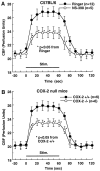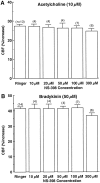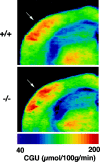Cyclooxygenase-2 contributes to functional hyperemia in whisker-barrel cortex
- PMID: 10632605
- PMCID: PMC6772412
- DOI: 10.1523/JNEUROSCI.20-02-00763.2000
Cyclooxygenase-2 contributes to functional hyperemia in whisker-barrel cortex
Abstract
The prostanoid-synthesizing enzyme cyclooxygenase-2 (COX-2) is expressed in selected cerebral cortical neurons and is involved in synaptic signaling. We sought to determine whether COX-2 participates in the increase in cerebral blood flow produced by synaptic activity in the somatosensory cortex. In anesthetized mice, the vibrissae were stimulated mechanically, and cerebral blood flow was recorded in the contralateral somatosensory cortex by a laser-Doppler probe. We found that the COX-2 inhibitor NS-398 attenuates the increase in somatosensory cortex blood flow produced by vibrissal stimulation. Furthermore, the flow response was impaired in mice lacking the COX-2 gene, whereas the associated increase in whisker-barrel cortex glucose use was not affected. The increases in cerebral blood flow produced by hypercapnia, acetylcholine, or bradykinin were not attenuated by NS-398, nor did they differ between wild-type and COX-2 null mice. The findings provide evidence for a previously unrecognized role of COX-2 in the mechanisms coupling synaptic activity to neocortical blood flow and provide an insight into one of the functions of constitutive COX-2 in the CNS.
Figures






References
-
- Adachi K, Takahashi S, Melzer P, Campos KL, Nelson T, Kennedy C, Sokoloff L. Increases in local cerebral blood flow associated with somatosensory activation are not mediated by NO. Am J Physiol. 1994;267:H2155–H2162. - PubMed
-
- Brock TG, McNish RW, Peters-Golden M. Arachidonic acid is preferentially metabolized by cyclooxygenase-2 to prostacyclin and prostaglandin E2. J Biol Chem. 1999;274:11660–11666. - PubMed
-
- Choi DW. Background genes: out of sight, but not out of brain. Trends Neurosci. 1997;20:499–500. - PubMed
-
- Dirnagl U, Lindauer U, Villringer A. Role of nitric oxide in the coupling of cerebral blood flow to neural activation in rats. Neurosci Lett. 1993;149:43–46. - PubMed
Publication types
MeSH terms
Substances
Grants and funding
LinkOut - more resources
Full Text Sources
Molecular Biology Databases
Research Materials
Miscellaneous
